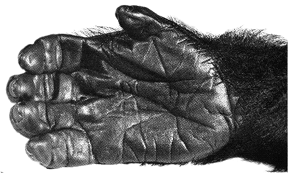Primate Anatomy
All primates have five
fingers on each hand. They also have nails instead of claws. However,
there are some primates who have a combination of nails and claws. In order
to be a primate, an animal must have at least one nail. The  thumb
is separated from the other fingers. This allows the thumb to be brought
into opposition with the other fingers. An opposable thumb improves the
ability of primates to securely grasp objects in their hands. As you can
imagine, climbing on small branches would require the hand to be able to
tightly grasp the branch. (click these pictures to see enlarged images)
thumb
is separated from the other fingers. This allows the thumb to be brought
into opposition with the other fingers. An opposable thumb improves the
ability of primates to securely grasp objects in their hands. As you can
imagine, climbing on small branches would require the hand to be able to
tightly grasp the branch. (click these pictures to see enlarged images)
Opposable Thumb Activity
Try and hold any object, such as
your pen without using your thumb. Not very easy, is it?
Are there any other animals you
can think of that can hold objects in their hands? List several advantages
that humans have, due to our ability to grasp objects?
Clavicle
All primates have a clavicle. Notice
that the dog does not have one. The clavical bone helps keep the arms out
to the side of the body. The presence of the clavical in primates contributes
to the mobility of the shoulder. The arms of primates can move in many
directions. In dogs, the mobility of the arm is limited to forward and
backward movements. A dog cannot lift his front legs out to the side of
his body.
.


Clavicle-Shoulder Activity
Without a clavicle your arm motion
is restricted to forward and backward movement only. Try the following
activities and note what must be done to accomplish them, if possible.
1. Try touching the chair next
to you.
2. Pat your head and rub your stomach.
3. Clasp hands together. Compare
pulling hands apart with elbows.
What activities would be improved
by moving the arms into many positions? List several activites you do that
require having your arms placed out to the side of your body.
Forearm Structure
and Movement
The forearm in primates contains
two separate bones, the ulna and the radius. These two bones rotate around
each other, allowing the palm of your hand to be turned up and down. The
ulna and radius are one bone in the dog, therefore the dog cannot turn
his paw upwards.
Why do you think dogs only have
one bone instead of two in their forearm?
Forearm Rotation Activity
1. Pick up the computer's mouse
and look at the underside. Note how your forearm rotated. Try it again
without using forearm rotation.
2. Pretend you are picking up and
eating an apple. How would you go about eating the apple if you could not
turn your hand towards your mouth?
What is the advantage of having
one bone instead of two in your forearm? How does forearm rotation aid
primates in gathering and eating food? What other activities can you think
of that requires the rotation of the arm?
Primate Feet
Primate feet illustrate their dependency upon climbing.
Compare these views:

 thumb
is separated from the other fingers. This allows the thumb to be brought
into opposition with the other fingers. An opposable thumb improves the
ability of primates to securely grasp objects in their hands. As you can
imagine, climbing on small branches would require the hand to be able to
tightly grasp the branch. (click these pictures to see enlarged images)
thumb
is separated from the other fingers. This allows the thumb to be brought
into opposition with the other fingers. An opposable thumb improves the
ability of primates to securely grasp objects in their hands. As you can
imagine, climbing on small branches would require the hand to be able to
tightly grasp the branch. (click these pictures to see enlarged images)



